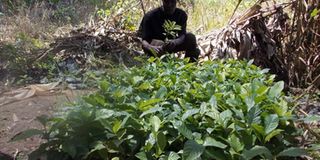Why growing clonal Robusta coffee is more paying

Mugera shows the clonal Robusta coffee plantlets in his nursery. Photo by Michael J Ssali
John Mugera of Nabulago village in Butale Parish, Kabonera Sub-county, Masaka District, is not only an agriculture extension service officer but also a farmer.
His work involves giving advice to farmers in the predominantly coffee growing district.
“I always tell them to appreciate the advantages of growing clonal Robusta coffee,” he says.
The word clonal means that the coffee plants have been multiplied asexually from a single parent plant or clone. Plant breeders under the National Agricultural Research Organisation (Naro) identified some six Robusta coffee clones, which are very high yielding and which had the most desired bean size.”
Mugera said that farmers are strictly advised to get their clonal coffee plantlets from well-established coffee nurseries that are also recognised by the Uganda Coffee Development Authority (UCDA).
Farmers’ nurseries
These are located in different places in all the Robusta coffee growing districts of the country.
“But farmers are free to establish their own nurseries if they follow the UCDA regulations,” said Mugera who has owned a mother garden and a clonal Robusta coffee nursery since 1989.
“One important step is to make a mother garden from which to obtain the cuttings for propagation. The mother garden must have only the said six different clones. They should not grow too tall and they should be nurtured in such a way that they produce a lot of suckers from which cuttings are obtained.”
A cutting is normally dipped in rooting powder called seradix before potting it in good and clean soil. Mugera however has discovered over the years that the farmer need not undergo the expense of buying seradix, which is obtained from agrochemical shops.
Root and shoot
He said he has successfully obtained good clonal Robusta coffee plantlets by just potting the cuttings in good clean soil that is conducive to root and shoot development.
“Soil that has been resting for some years and is rich in organic matter such as that in the forest is the best for this work,” he said. He also warned that the farmer has to ensure that the soil does not contain seeds of dangerous weeds.
He went on to disclose that a cutting is placed individually in a single pot which is filled with soil. The pots should be open at both the top and the bottom and they should have some holes in the sides to allow free passage of water and air.
A coffee nursery operator may prepare thousands of such potted cuttings and the next stage is to place them under a shade and cover them with clear, transparent, polythene tents to induce a high humidity environment.
The tents should be three feet wide and may be of any length depending on the number of cuttings under preparation. Every week for about two months the farmer opens up the polythene cover tent to water the rooting cuttings.
As the cuttings gain more roots and leaves, usually after two or three months, the farmer should water them twice or more a week. He said the best time for watering is in the morning or in the evening.
Adequate time
The cuttings may be uncovered for hardening after some five months and irrigated frequently under light shade. Mugera said the cuttings are ready for planting after nine months.
He further said that a farmer intending to grow clonal Robusta coffee should dig holes about three feet deep and three feet wide and fill them up with top soil, preferably mixed with organic manure, some three months before planting the clonal Robusta coffee cutting.
The idea is to provide enough time for the manure to decompose. At the time of planting the polythene bag containing the soil in which the cutting developed must be torn off and taken for burning.
One cutting is planted in each hole and the soil where the cutting is planted should be the same level as that of the rest of the field.
Planting should take place at the beginning of the rain season unless the farmer has the means to carry out irrigation.
Mugera insists that cuttings from all the six clone types should be planted in every garden for best results. The plantlets should be protected from the scorching sun by placing banana leaves or palm leaves around them.
clonal coffee
The plant breeders propagated plantlets from them by cloning and these are the ones that have been multiplied over the years and which I tell the farmers to grow.
The descendants of each clone (original coffee plant) are exactly identical wherever they are planted and as one walks through a clonal Robusta coffee garden it is easy to identify the descendants of the six different clones.” He said the clones are classified as A, B, C, D, F, and H. All descendants of these clones wherever they grow have proved to be high yielding if proper farming practices are applied. Their other big advantage is that they begin to bear fruit much earlier than the plants raised from seeds planted in the field at the same time. Clonal Robusta coffee begins fruition at between 24 and 36 months.




